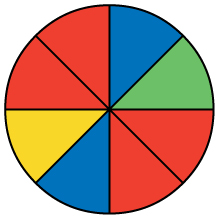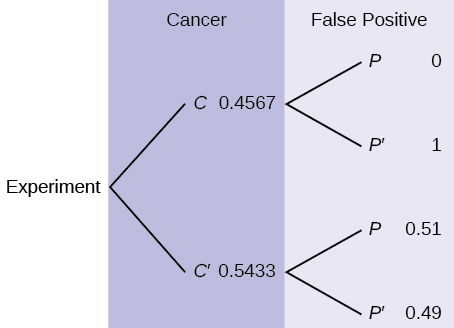Chapter 3: Probability Topics
Chapter 3 Practice
Section 3.1
In a particular college class, there are male and female students. Some students have long hair and some students have short hair. Write the symbols for the probabilities of the events for parts a through j. (Note that you cannot find numerical answers here. You were not given enough information to find any probability values yet; concentrate on understanding the symbols.)
- Let F be the event that a student is female.
- Let M be the event that a student is male.
- Let S be the event that a student has short hair.
- Let L be the event that a student has long hair.
- The probability that a student does not have long hair.
- The probability that a student is male or has short hair.
- The probability that a student is a female and has long hair.
- The probability that a student is male, given that the student has long hair.
- The probability that a student has long hair, given that the student is male.
- Of all the female students, the probability that a student has short hair.
- Of all students with long hair, the probability that a student is female.
- The probability that a student is female or has long hair.
- The probability that a randomly selected student is a male student with short hair.
- The probability that a student is female.
Solution
- P(L′) = P(S)
- P(M OR S)
- P(F AND L)
- P(M|L)
- P(L|M)
- P(S|F)
- P(F|L)
- P(F OR L)
- P(M AND S)
- P(F)
Use the following information to answer the next four exercises. A box is filled with several party favors. It contains 12 hats, 15 noisemakers, ten finger traps, and five bags of confetti.
- Let H = the event of getting a hat.
- Let N = the event of getting a noisemaker.
- Let F = the event of getting a finger trap.
- Let C = the event of getting a bag of confetti.
Find P(H).
Find P(N).
Solution
P(N) = [latex]\frac{15}{42}[/latex] = [latex]\frac{5}{14}[/latex] = 0.36
Find P(F).
Find P(C).
Solution
P(C) = [latex]\frac{5}{42}[/latex] = 0.12
Use the following information to answer the next six exercises. A jar of 150 jelly beans contains 22 red jelly beans, 38 yellow, 20 green, 28 purple, 26 blue, and the rest are orange.
Let B = the event of getting a blue jelly bean
Let G = the event of getting a green jelly bean.
Let O = the event of getting an orange jelly bean.
Let P = the event of getting a purple jelly bean.
Let R = the event of getting a red jelly bean.
Let Y = the event of getting a yellow jelly bean.
Find P(B).
Find P(G).
Solution
P(G) = [latex]\frac{20}{150}[/latex] = [latex]\frac{2}{15}[/latex] = 0.13
Find P(P).
Find P(R).
Solution
P(R) = [latex]\frac{22}{150}[/latex] = [latex]\frac{11}{75}[/latex] = 0.15
Find P(Y).
Find P(O).
Solution
P(O) = [latex]\frac{150-22-38-20-28-26}{150}[/latex] = [latex]\frac{16}{150}[/latex] = [latex]\frac{8}{75}[/latex] = 0.11
Use the following information to answer the next six exercises. There are 23 countries in North America, 12 countries in South America, 47 countries in Europe, 44 countries in Asia, 54 countries in Africa, and 14 in Oceania (Pacific Ocean region).
Let A = the event that a country is in Asia.
Let E = the event that a country is in Europe.
Let F = the event that a country is in Africa.
Let N = the event that a country is in North America.
Let O = the event that a country is in Oceania.
Let S = the event that a country is in South America.
Find P(A).
Find P(E).
Solution
P(E) = [latex]\frac{47}{194}[/latex] = 0.24
Find P(F).
Find P(N).
Solution
P(N) = [latex]\frac{23}{194}[/latex] = 0.12
Find P(O).
Find P(S).
Solution
P(S) = [latex]\frac{12}{194}[/latex] = [latex]\frac{6}{97}[/latex] = 0.06
What is the probability of drawing a red card in a standard deck of 52 cards?
What is the probability of drawing a club in a standard deck of 52 cards?
Solution
[latex]\frac{13}{52}[/latex] = [latex]\frac{1}{4}[/latex] = 0.25
What is the probability of rolling an even number of dots with a fair, six-sided die numbered one through six?
What is the probability of rolling a prime number of dots with a fair, six-sided die numbered one through six?
Solution
[latex]\frac{3}{6}[/latex] = [latex]\frac{1}{2}[/latex] = 0.5
Use the following information to answer the next two exercises. You see a game at a local fair. You have to throw a dart at a color wheel. Each section on the color wheel is equal in area.

Let B = the event of landing on blue.
Let R = the event of landing on red.
Let G = the event of landing on green.
Let Y = the event of landing on yellow.
If you land on Y, you get the biggest prize. Find P(Y).
If you land on red, you don’t get a prize. What is P(R)?
Solution
[latex]P\left(R\right)=\frac{4}{8}=0.5[/latex]
Use the following information to answer the next ten exercises. On a baseball team, there are infielders and outfielders. Some players are great hitters, and some players are not great hitters.
Let I = the event that a player is an infielder.
Let O = the event that a player is an outfielder.
Let H = the event that a player is a great hitter.
Let N = the event that a player is not a great hitter.
Write the symbols for the probability that a player is not an outfielder.
Write the symbols for the probability that a player is an outfielder or is a great hitter.
Solution
P(O OR H)
Write the symbols for the probability that a player is an infielder and is not a great hitter.
Write the symbols for the probability that a player is a great hitter, given that the player is an infielder.
Solution
P(H|I)
Write the symbols for the probability that a player is an infielder, given that the player is a great hitter.
Write the symbols for the probability that of all the outfielders, a player is not a great hitter.
Solution
P(N|O)
Write the symbols for the probability that of all the great hitters, a player is an outfielder.
Write the symbols for the probability that a player is an infielder or is not a great hitter.
Solution
P(I OR N)
Write the symbols for the probability that a player is an outfielder and is a great hitter.
Write the symbols for the probability that a player is an infielder.
Solution
P(I)
What is the word for the set of all possible outcomes?
What is conditional probability?
Solution
The likelihood that an event will occur given that another event has already occurred.
A shelf holds 12 books. Eight are fiction and the rest are nonfiction. Each is a different book with a unique title. The fiction books are numbered one to eight. The nonfiction books are numbered one to four. Randomly select one book
Let F = event that book is fiction
Let N = event that book is nonfiction
What is the sample space?
What is the sum of the probabilities of an event and its complement?
Solution
1
Use the following information to answer the next two exercises. You are rolling a fair, six-sided number cube. Let E = the event that it lands on an even number. Let M = the event that it lands on a multiple of three.
What does P(E|M) mean in words?
What does P(E OR M) mean in words?
Solution
the probability of landing on an even number or a multiple of three
Section 3.2
E and F are mutually exclusive events. P(E) = 0.4; P(F) = 0.5. Find P(E∣F).
J and K are independent events. P(J|K) = 0.3. Find P(J).
Solution
P(J) = 0.3
U and V are mutually exclusive events. P(U) = 0.26; P(V) = 0.37. Find:
- P(U AND V) =
- P(U|V) =
- P(U OR V) =
Q and R are independent events. P(Q) = 0.4 and P(Q AND R) = 0.1. Find P(R).
Solution
P(Q AND R) = P(Q)P(R)
0.1 = (0.4)P(R)
P(R) = 0.25
Section 3.3
Use the following information to answer the next ten exercises. Forty-eight percent of all Californians registered voters prefer life in prison without parole over the death penalty for a person convicted of first degree murder. Among Latino California registered voters, 55% prefer life in prison without parole over the death penalty for a person convicted of first degree murder. 37.6% of all Californians are Latino.
In this problem, let:
Suppose that one Californian is randomly selected.
Find P(C).
Find P(L).
Solution
0.376
Find P(C|L).
In words, what is C|L?
Solution
C|L means, given the person chosen is a Latino Californian, the person is a registered voter who prefers life in prison without parole for a person convicted of first degree murder.
Find P(L AND C).
In words, what is L AND C?
Solution
L AND C is the event that the person chosen is a Latino California registered voter who prefers life without parole over the death penalty for a person convicted of first degree murder.
Are L and C independent events? Show why or why not.
Find P(L OR C).
Solution
0.6492
In words, what is L OR C?
Are L and C mutually exclusive events? Show why or why not.
Solution
No, because P(L AND C) does not equal 0.
Section 3.4
Use the following information to answer the next four exercises. The following table shows a random sample of musicians and how they learned to play their instruments. Find P(musician is a female).
| Gender | Self-taught | Studied in School | Private Instruction | Total |
| Female | 12 | 38 | 21 | 71 |
| Male | 19 | 24 | 15 | 58 |
| Other | 0 | 0 | 1 | 1 |
| Total | 31 | 62 | 37 | 130 |
Find P(musician is a male AND had private instruction).
Solution
P(musician is a male AND had private instruction) = [latex]\frac{15}{130}[/latex] = [latex]\frac{3}{26}[/latex] = 0.12
Find P(musician is a female OR is self taught).
Are the events “being a female musician” and “learning music in school” independent events?
Solution
P(being a female musician AND learning music in school) = [latex]\frac{38}{130}[/latex] = [latex]\frac{19}{65}[/latex] = 0.29
P(being a female musician)P(learning music in school) = [latex]\left(\frac{72}{130}\right)\left(\frac{62}{130}\right)[/latex] = [latex]\frac{4,464}{16,900}[/latex] = [latex]\frac{1,116}{4,225}[/latex] = 0.26
No, they are not independent because P(being a female musician AND learning music in school) is not equal to P(being a female musician)P(learning music in school).
Section 3.5
The probability that a man develops some form of cancer in his lifetime is 0.4567. The probability that a man has at least one false positive test result (meaning the test comes back for cancer when the man does not have it) is 0.51. Let: C = a man develops cancer in his lifetime; P = man has at least one false positive. Construct a tree diagram of the situation.
Solution


